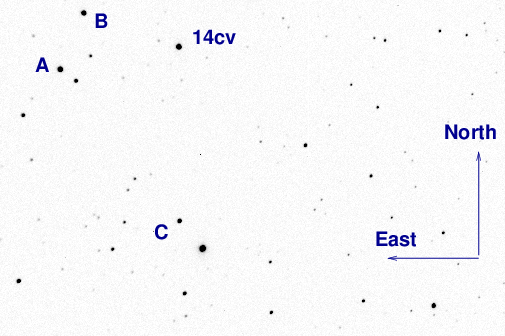
On the night of Jun 21/22, 2014, I observed the cataclysmic variable stars ASAS-SN14cv and ASAS-SN14cl. You can read more about these stars, which were both discovered only recently, at
The first star -- 14cv -- appears to have started its "superhumping" behavior during my run. Cool! The other star -- 14cl -- showed some very clear superhumps, too.
The main setup was:
Notes from the night
Here's a chart of the field of ASAS-SN14cv, which is at
RA = 17:43:48.58 Dec = +52:03:46.8 (J2000)

Some of the reference stars marked above have magnitudes in the UCAC4. Specifically, star "A" above is
I started with 30-second exposures of this star, but it came close reaching the 15-bit limit of 32767. I switched to 25-second exposures, but it still occasionally exceeded that value. Therefore, I divided all the raw frames by 2 before continuing the reductions.
Below is a plot showing the sky brightness during the night. The jump in the middle occurs when I switch from ASAS-14cv to ASAS-14cl. Note the bump at the end -- clouds came just before dawn.

You can see the effect of changing the exposure time in the image adjustment factor:
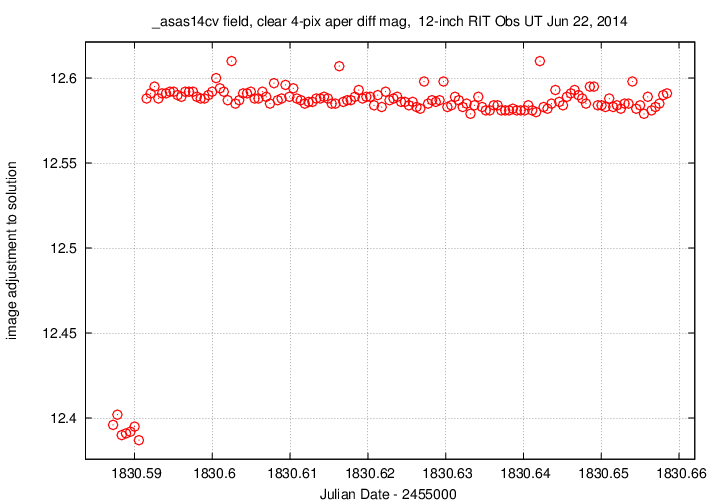
Using aperture photometry with a radius of 4 pixels (radius of 7.4 arcsec), I measured the instrumental magnitudes of a number of reference stars and the target. Following the procedures outlined by Kent Honeycutt's article on inhomogeneous ensemble photometry, I used all stars available in each image to define a reference frame, and measured each star against this frame. I used the AAVSO V-band magnitude of star "B" to convert the ensemble instrumental magnitudes to a reported "V"-band magnitude (but remember, it's a clear filter).
The target is the brightest star below; its scatter is quite a bit larger than that of stars of similar brightness.
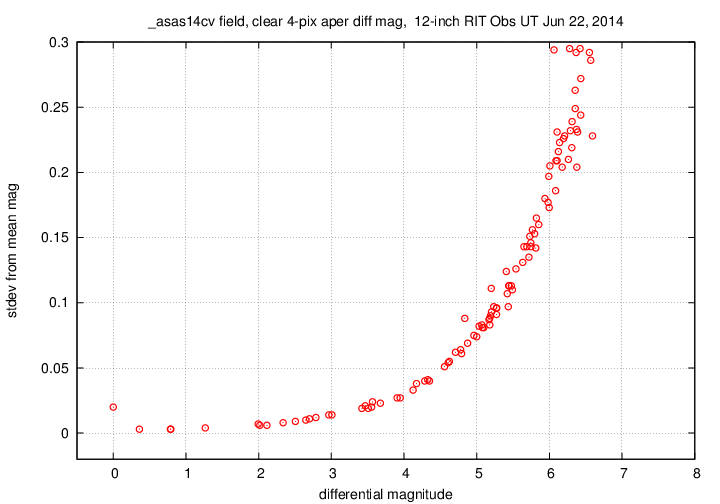
The target had a "V"-band magnitude of roughly 11.2, and though it was steady early in my observations, it suddenly started "humping" at about JD 1830.65. Excellent!
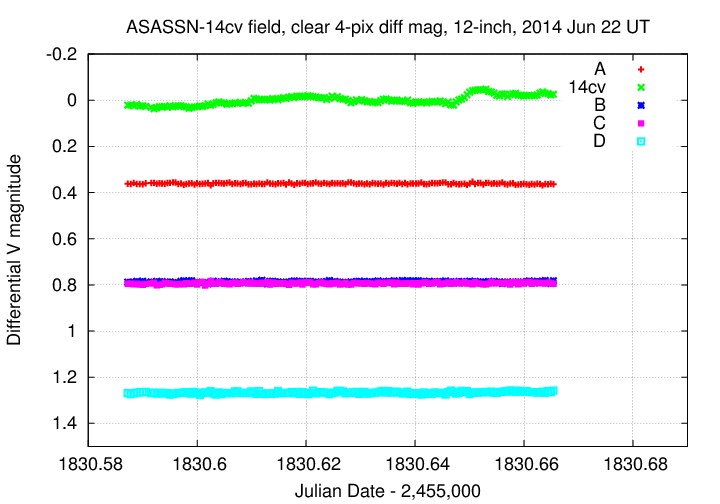
You can see my measurements of the star in the ASCII text file below. The first few lines are shown here:
# Measurements of ASAS_SN14cv made at RIT Obs, Jun 22, 2014 UT, # in good conditions, # by Michael Richmond, using 12-inch Meade and SBIG ST-8E CCD. # Exposures 25 or 30 seconds long, no filter. # Tabulated times are midexposure (FITS header time - half exposure length) # and accurate only to +/- 1 second (??). # 'mag' is a differential magnitude based on ensemble photometry # using a circular aperture of radius 7.4 arcseconds. # which has been shifted so UCAC4 711-058151 has mag=11.518 # which is its V-band mag according to UCAC4. # # UT_day JD HJD mag uncert Jun22.08725 2456830.58725 2456830.58871 11.178 0.003 Jun22.08780 2456830.58780 2456830.58926 11.178 0.003 Jun22.08836 2456830.58836 2456830.58982 11.181 0.003
Here's a chart of the field of ASAS-SN14cl, which is at
RA = 21:54:57.62 Dec = +26:41:16 (J2000)

Some of the reference stars marked above have magnitudes the UCAC4 AAVSO chart 13493SS. Specifically, star "B" above is
I took 30-second guided images through clear filter. There's a good guide star available if the target is placed on the chip at (353, 143). After discarding the bad images, I was left with 164 images.

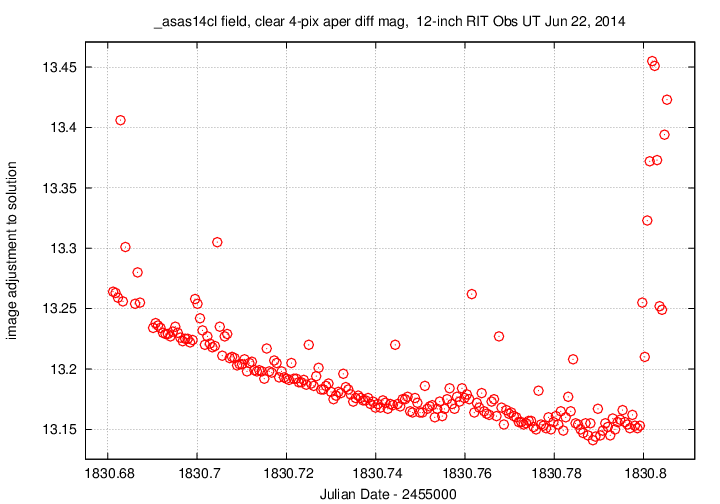
Using aperture photometry with a radius of 4 pixels (radius of 7.4 arcsec), I measured the instrumental magnitudes of a number of reference stars and the target. Following the procedures outlined by Kent Honeycutt's article on inhomogeneous ensemble photometry, I used all stars available in each image to define a reference frame, and measured each star against this frame. I used the AAVSO V-band magnitude of star "B" to convert the ensemble instrumental magnitudes to a reported "V"-band magnitude (but remember, it's a clear filter).
The target is the second-brightest star below; its scatter is much larger than that of stars of similar brightness.
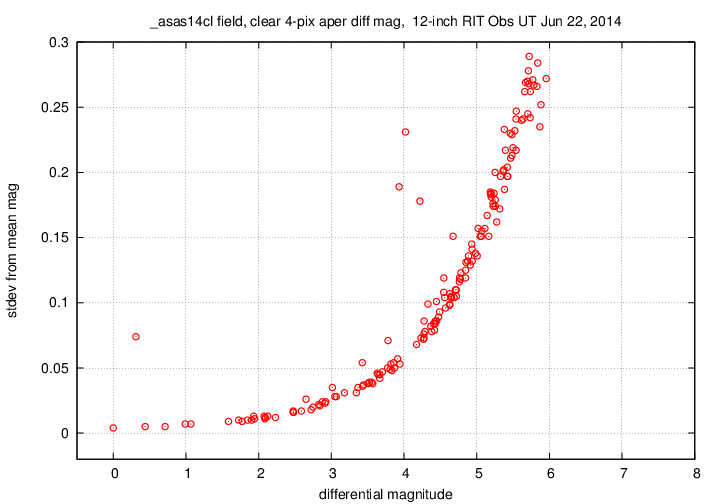
The target had a "V"-band magnitude of roughly 12.0, and it showed just a little bit of gradual, slow variation over the course of the 2.4 hour observations:
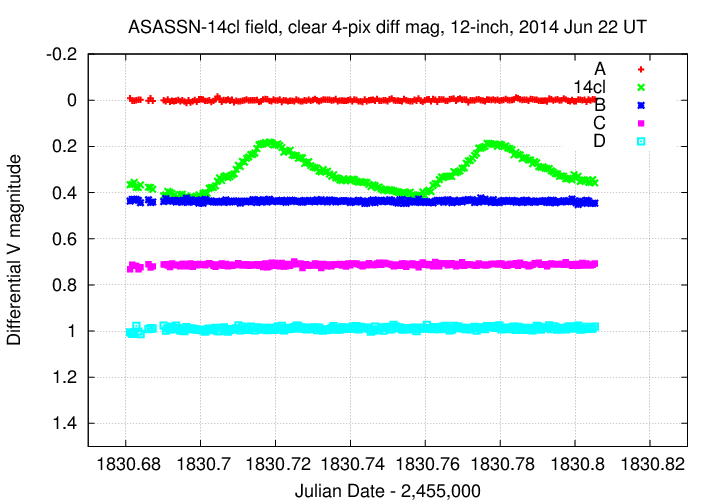
Grab the text file below for all the RIT measurements of ASAS-SN14cl. The header of the file is shown below.
# Measurements of ASAS_SN14cl made at RIT Obs, Jun 20, 2014 UT, # in good conditions, # by Michael Richmond, using 12-inch Meade and SBIG ST-8E CCD. # Exposures 30 seconds long, no filter. # Tabulated times are midexposure (FITS header time - half exposure length) # and accurate only to +/- 1 second (??). # 'mag' is a differential magnitude based on ensemble photometry # using a circular aperture of radius 7.4 arcseconds. # which has been shifted so UCAC4 584-123918 has mag=12.335 # which is its V-band mag according to AAVSO chart 13493SS. # # UT_day JD HJD mag uncert Jun20.14007 2456828.64007 2456828.64140 12.105 0.007 Jun20.14065 2456828.64065 2456828.64198 12.104 0.007 Jun20.14124 2456828.64124 2456828.64257 12.085 0.006
Last modified 6/22/2014 by MWR.